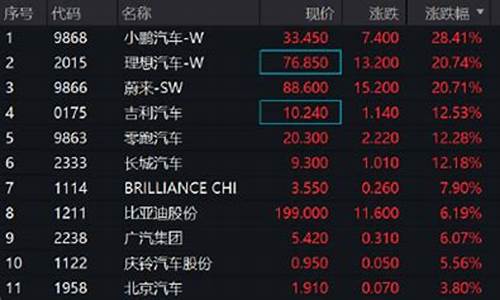您现在的位置是: 首页 > 车型大全 车型大全
riviera maison_RIVIERA MAISON是什么品牌
佚名 2024-05-24 人已围观
简介rivieramaison_RIVIERAMAISON是什么品牌现在,请允许我来为大家分享一些关于rivieramaison的相关知识,希望我的回答可以给大家带来一些启发。关于rivieramaison的讨
现在,请允许我来为大家分享一些关于riviera maison的相关知识,希望我的回答可以给大家带来一些启发。关于riviera maison的讨论,我们开始吧。
1.riviera maison

riviera maison
早年生话:
Gabrielle Bonheur Chanel was born to an unwed mother, Eugénie "Jeanne" Devolle, a laundrywoman, in "the charity hospital run by the Sisters of Providence"[3] in Saumur, France. She was Devolle's second daughter. Her father, Albert Chanel, was an itinerant street vendor who peddled work clothes and undergarments,[4]living a nomadic life, traveling to and from market towns, while the family resided in rundown lodgings. In 1884, he married Jeanne Devolle,[5] persuaded to do so by her family who had "united, effectively, to pay Albert to marry her/"[6] At birth, Chanel's name was entered into the official registry as "Chasnel". Jeanne was too unwell to attend the registration, and Albert was registered as "travelling".[3] With both parents absent, the infant's last name was misspelled, probably due to a clerical error. The couple eventually had five other children: Julia-Berthe (1882–1912), Antoinette (born 1887), and the three sons, Alphonse (1885-1953), Lucien (born 1889), and Augustin, who died in infancy.
In 1895, when Gabrielle was twelve years old, her mother died of bronchitis[7] at age thirty-one.[7] Gabrielle's father sent his two sons out to work as farm laborers and sent his three daughters to the Corrèze, in central France, to the convent of Aubazine, whose religious order, the Congregation of the Sacred Heart of Mary, was "founded to care for the poor and rejected, including running homes for abandoned and orphaned girls".[8] It was a stark, frugal life, demanding strict discipline. At age eighteen, Chanel, too old to remain at Aubazine, went to live in a boarding house set aside for Catholic girls in the town ofMoulins.[9]
Later in life, Chanel fabricated her history, concocting elaborate fictions in order to obscure her humble origins. Of the various stories told about Coco Chanel, a great number were of her own invention. These legends were to prove the undoing of her earliest biographies. These were ghosted memoirs commissioned by Chanel herself, but never published, always aborted before fruition, as she realized that the facts exposed a personage less laudatory than the mythic Chanel she had invented. Chanel would steadfastly claim that when her mother died, her father sailed for America to seek his fortune and she was sent to live with two cold-hearted sinister aunts. She even claimed to have been born in 1893 instead of 1883 and that her mother had died when Coco was two instead of twelve.
事业初期:
Having learned the art of sewing during her six years at Aubazine, Chanel was able to find employment as a seamstress. When not plying her needle, she sang in a cabaret frequented by cavalry officers. Chanel made her stage debut singing at a café-concert (a popular entertainment venue of the era) in a Moulins pavilion, "La Rotonde". She was among other girls dubbed poseuses, the performers who entertained the crowd between star turns. The money earned was what they managed to accumulate when the plate was passed among the audience in appreciation of their performance. It was at this time that Gabrielle acquired the name "Coco", possibly based on two popular songs with which she became identified, "Ko Ko Ri Ko", and "Qui qu'a vu Coco", or it was an allusion to the French word for kept woman, cocotte.[11] As cafe entertainer, Chanel radiated a juvenile allure that tantalized the military habitués of the cabaret.[9]
The year 1906 found Chanel in the spa resort town of Vichy. Vichy boasted a profusion of concert halls, theatres and cafes where Chanel hoped to find success as a performer. Chanel's youth and physical charms impressed those for whom she auditioned, but her singing voice was marginal and she failed to find stage work.[12] Obliged to find employment, she took work at the "Grande Grille", where as a donneuse d'eau she was one of the females whose job it was to dispense glasses of the purportedly curative mineral water for which Vichy was renowned.[13] When the Vichy season ended, Chanel returned to Moulins, and her former haunt "La Rotonde". She now realized that a serious stage career was not in her future.[14]
早期赞助人(有涉及爱情方面)
It was at Moulins that Chanel met the young French ex-cavalry officer and wealthy textile heir ?tienne Balsan. At the age twenty-three, Chanel became Balsan's mistress, supplanting the courtesan ?milienne d'Alen?on as his new favorite.[15] For the next three years, she lived with him in his chateau Royallieu near Compiègne, an area known for its wooded equestrian paths and the hunting life.[16] It was a life style of self-indulgence, Balsan's wealth and leisure allowing the cultivation of a social set who reveled in partying and the gratification of human appetites with all the implied accompanying decadence. Balsan lavished Chanel with the beauties of "the rich life"—diamonds, dresses, and pearls. Biographer Justine Picardie, in her 2010 study Coco Chanel: The Legend and the Life (Harper Collins), suggests that the fashion designer's nephew, André Palasse, supposedly the only child of her sister Julia-Berthe who had committed suicide, was actually Chanel's child by Balsan.
In 1908 Chanel began an affair with one of Balsan's friends, Captain Arthur Edward 'Boy' Capel.[17] In later years, Chanel reminisced of this time in her life: "two gentlemen were outbidding for my hot little body."[18] Capel, a wealthy member of the English upper class, installed Chanel in an apartment in Paris.[19] and financed Chanel's first shops. It is said that Capel's own sartorial style influenced the conception of the Chanel look. The bottle design for Chanel No. 5 had two probable origins, both attributable to the sophisticated design sensibilities of Capel. It is believed Chanel adapted the rectangular, beveled lines of the Charvet toiletry bottles he carried in his leather traveling case[20] or it was the design of the whiskey decanter Capel used and Chanel so admired that she wished to reproduce it in "exquisite, expensive, delicate glass".[21] The couple spent time together at fashionable resorts such as Deauville, but he was never faithful to Chanel.[22] The affair lasted nine years, but even after Capel married an English aristocrat, Lady Diana Wyndham in 1918, he did not completely break off with Chanel. His death in a car accident, in late 1919, was the single most devastating event in Chanel's life.[23] She commissioned the placement of a roadside memorial at the site of the accident, which she visited in later years to lay flowers in remembrance.[24] Twenty-five years after the event, Chanel then residing in Switzerland, confided to her friend Paul Morand: "His death was a terrible blow to me. In losing Capel, I lost everything. What followed was not a life of happiness, I have to say."[25]
Chanel began designing hats while living with Balsan, initially as a diversion that evolved into a commercial enterprise. She became a licensed modiste (hat maker) in 1910 and opened a boutique at 21 rue Cambon, Paris named Chanel Modes.[26] As this location already housed an established clothing business, Chanel sold only her millinery creations at this address. Chanel's modiste career bloomed once theatre actressGabrielle Dorziat modelled her hats in the F Noziere's play Bel Ami in 1912. Subsequently, Dorziat modelled her hats again in Les Modes.[26]
Deauville and Biarritz
In 1913, Chanel opened a boutique in Deauville financed by Arthur Capel where she introduced deluxe casual clothes suitable for leisure and sport. The fashions were constructed from humble fabrics such as jersey and tricot, primarily used for men's underwear.[26] The location was a prime one, in the center of town on a fashionable street. Here Chanel sold hats, jackets, sweaters, and the marinière, the sailor blouse. Chanel had the dedicated support of two family members. One was her sister, Antoinette. The other was Adrienne Chanel, a woman close to Chanel's own age, yet, remarkably her aunt; the child of a union her grandfather had had late in his life.[27] Adrienne and Antoinette, were recruited to model her designs; on a daily basis the two women paraded through the town and on its boardwalks, advertising the Chanel creations.[28]
Chanel, determined to re-create the success she had enjoyed in Deauville, opened an establishment in Biarritz in 1915. Biarritz, situated on the C?te Basque, in proximity to wealthy Spanish clients, had the status of neutrality during World War I, allowing it to become the playground for the moneyed and those exiled from their native countries by the hostilities.[29] The Biarritz shop was installed not as a storefront, but in a villa opposite the casino. After only one year of operation, the business proved to be so lucrative that in 1916 Chanel was able to reimburse Capel his original investment—a decision Chanel made on her own, without Capel's input.[30] It was in Biarritz that Chanel made the acquaintance of an expatriate aristocrat, the Grand Duke Dmitri Pavlovich of Russia. They had a romantic interlude, and maintained a close association for many years afterward.[31] By 1919, Chanel was registered as a couturiere and established her maison de couture at 31 rue Cambon.[26]
创立品牌
In 1918, Chanel was able to acquire the entire building at 31 rue Cambon situated in one of the most fashionable districts of Paris. In 1921, she opened what may be considered an early incarnation of the fashion boutique, featuring clothing, hats, and accessories later expanded to offer jewelry and fragrance. By 1927, Chanel owned an expanse of five properties on the rue Cambon, encompassing buildings numbered 23 through 31.[32]
In 1920, she was introduced by the ballet impresario Sergei Diaghilev to Igor Stravinsky. Now a notable patron of the arts, Chanel guaranteed the production of the ballet Le Sacre du Printemps ("The Rite of Spring") against financial loss, and provided her new home Bel Respiro, located in a Paris suburb, as a residence for composer Stravinsky and his family.[33] In addition to turning out her couture collections, Chanel threw her prodigious energies into designing dance costumes for the cutting-edge Ballet Russe. Between the years 1923-1937, she collaborated on productions choreographed by Diaghilev and dancerVaslav Nijinsky, notably Le Train bleu, a dance-opera, Orphée and Oedipe Roi.[34]
In 1922, at the Longchamps races, Théophile Bader, founder of the Paris Galeries Lafayette, introduced Chanel to businessmanPierre Wertheimer. Bader was interested in inaugurating the sale of the Chanel No. 5 fragrance in his department store.[35]In 1924, Chanel made an agreement with the Wertheimer brothers, Pierre and Paul, directors of the eminent perfume and cosmetics house Bourgeois since 1917, creating a corporate entity, "Parfums Chanel." The Wertheimers agreed to provide full financing for production, marketing and distribution of Chanel No. 5. The Wertheimers would receive seventy percent of the profits, and Théophile Bader a twenty percent share. For ten percent of the stock, Chanel licensed her name to Parfums Chaneland removed herself from involvement in all business operations.[36] Displeased with the arrangement, Chanel worked for more than twenty years to gain full control of Parfums Chanel.[35][36] She proclaimed that Pierre Wertheimer was "the bandit who screwed me".[37]
One of Chanel's longest and enduring associations was with Misia Sert, a notable member of the Parisian, bohemian elite and wife of Spanish painter José-Maria Sert. It is said that theirs was an immediate bond of like souls, and Misia was attracted to Chanel by "her genius, lethal wit, sarcasm and maniacal destructiveness, which intrigued and appalled everyone".[38] Both women, convent bred, maintained a friendship of shared interests, confidences and drug use. By 1935, Chanel had become a habitual drug user, injecting herself with morphine on a daily basis until the end of her life.[39] According to Chandler Burr's The Emperor of Scent, Luca Turin related an apocryphal story in circulation that Chanel was "called Coco because she threw the most fabulous cocaine parties in Paris".[40]
The writer Colette, who moved in the same social circles as Chanel, provided a whimsical description of Chanel at work in her atelier, which appeared in "Prisons et Paradis" (1932). "If every human face bears a resemblance to some animal, then Mademoiselle Chanel is a small black bull. That tuft of curly black hair, the attribute of bull-calves, falls over her brow all the way to the eyelids and dances with every maneuver of her head."[41]
[edit]Associations with the British Aristocracy
In 1923, Vera Bate Lombardi, (born Sarah Gertrude Arkwright),[42] reputedly the illegitimate daughter of the Marquess of Cambridge,[42] afforded Chanel entry into the highest levels of British aristocracy. It was an elite group of associations revolving around such personages as Winston Churchill, aristocrats such as the Duke of Westminster, and royals such as Edward, Prince of Wales. It was in Monte Carlo in 1923, at age forty that Chanel was introduced by Lombardi to the vastly wealthy Duke of Westminster, Hugh Richard Arthur Grosvenor, known to his intimates as "Bendor". The Duke of Westminster lavished Chanel with extravagant jewels, costly art, and a home in London's prestigious Mayfair district. His affair with Chanel lasted ten years.[43]
The Duke, an outspoken anti-Semite, intensified Chanel's inherent antipathy toward Jews and shared with her an expressed homophobia. In 1946, Chanel was quoted by her friend and confidante, Paul Morand:
"Homosexuals? … I have seen young women ruined by these awful queers: drugs, divorce, scandal. They will use any means to destroy a competitor and to wreak vengeance on a woman. The queers want to be women—but they are lousy women. They are charming!"[44]
Coinciding with her introduction to the Duke, was her introduction, again through Lombardi, to Lombardi's cousin, the Prince of Wales, Edward VIII. The Prince became smitten with Chanel and pursued her in spite of her involvement with the Duke of Westminster. It is said that he visited Chanel in her apartment and requested that she call him "David", a privilege reserved only for his closest friends and family. Years later, Diana Vreeland, editor of Vogue, would insist that "the passionate, focused and fiercely independent Chanel, a virtual tour de force," and the Prince "had a great romantic moment together".[45]
In 1927, the Duke of Westminster gifted Chanel with a parcel of land he had purchased in Roquebrune-Cap-Martin on the French Riviera. It was on this site that Chanel built her villa, La Pausa ("restful pause"), hiring the architect Robert Streitz. Streitz's concept for the staircase and patio contained design elements inspired by Aubazine, the orphanage in which Chanel spent her youth.[46][47] When asked why she did not marry the Duke of Westminster, she stated: "There have been several Duchesses of Westminster. There is only one Chanel."[48]
未完,急事出去,回头给你全的
ing later on milliner of the Maison Riva Marchesi and finally reaching the famous Madame Paulette. In 1981 he founded his personal griffe in a total countertrend to the almost final decline of the “little hat”, finding enthusiastic allies as the designers Gaultier,Miyake and Montana. In the same time he proposes a new collection of gloves, handbags and shoes…The success of Philippe Model’s shoes collection comes surely from the refined taste of the product, from the washed lather and from the handmade flavor that gives more value and characterize the product.
Every production stage is devolved upon a company located in Riviera del Brenta ( famous Italian area for the quality of shoes production) where the shoe arise from the lather cut, proceeding through the handmade assembly of the sole until the final upper polishing, made shoe by shoe. The aseptic industrial production system doesn’t contaminate our work philosophy, on the contrary, sometimes, it is characterized from slight differences between shoes, which cannot be considered a flaw, but a sign of an handmade work never like as itself
好了,关于“riviera maison”的话题就到这里了。希望大家通过我的介绍对“riviera maison”有更全面、深入的认识,并且能够在今后的实践中更好地运用所学知识。









